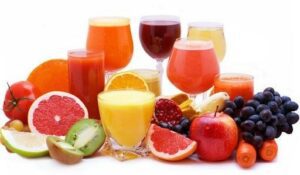juice industry is defined in the standard specifications as the natural juice of healthy, ripe, unfermented fruits or vegetables, containing all or part of the pulp, free of seeds,
husks and coarse fibers. and treated by one of the appropriate methods of preservation in the event that it is not consumed immediately after preparation on the condition that it is preserved As much as possible of its fresh qualities and nutritional value.

Table of Contents
The chemical composition of the juice and its nutritional value: juice industry
juice industry Fruit and vegetable juices are known to be rich in vitamins and minerals. and have a good percentage of sugars, but fruit and vegetable juices are generally considered poor in protein and fatty substances. Also, the juice has a high percentage of water, so it quenches thirst. For example, the percentage of sugars ranges from 2% to 16.8%.
Raw materials used in the juice industry:
- Fruits: Municipal oranges – lemons – grapefruit – mango – grapes – pomegranate – guava -apples – persimmons – peaches – bananas.
- Vegetables: strawberry – tomato – carrot – pineapple.
Steps for juice industry:
1- Choosing the right type:
first step in juice industry is to know that Not all types of fruits or vegetables are suitable for making juice, and we have to choose varieties that are abundant in juice, with strong flavor, desirable taste and aroma, and high nutritional value, and that withstand the steps of juice-making without changing to a bitter taste, for example, like some lemon varieties, and without losing a great deal of flavor The characteristic of fruits or vegetables, and without affecting the industrial processes on a large amount of their nutritional value.
The selected variety should facilitate the extraction of its juice in an economical way, and the consumer’s desire must be taken into consideration. It is taken into account that the raw material is in the appropriate degree of maturity for this industry. The raw material must also be intact, free from mechanical scratches, mold, fermentation, fungi and any other defects, and the higher the quality of the raw material, the higher the final product will be, and the poor raw materials cannot produce a good product, and this is a correct rule in all forms of food processing.
2- sorting:
After receiving the raw material, a sorting process is conducted in order to exclude the damaged, crushed, incompletely colored, and incompletely ripened ones. The purpose of the sorting process is to exclude defects that affect the quality characteristics of the final juice.
3- Washing:
Washing is a very important step that leads to the following:
A- Dispose of what is attached to agricultural raw materials such as sand, dust and mud.
b- Removing insecticides, fungal and bacterial pesticides, which are chemicals that may be toxic, or affect the taste, color and smell of the juice.
C- Washing operations reduce the microorganisms polluting the raw materials, and this leads to an increase in the efficiency of the preservation process that will take place later.
4- Extracting the juice: in juice industry
Fruit juice is generally acidic, and vegetable juice is not acidic (except for tomatoes) and acids affect the mineral substances that make up juices, so metals corrode and juice acquires a metallic taste. The acidity of the juice does not affect the juice, and the best juicers are those made of stainless steel, German silver, or nickel-chrome-plated steel. Solid wood is also used that does not affect the taste of the juice, or any other characteristic in it, in making cones. Extracting citrus juice, such as orange, is suitable for this purpose, beech, oak or cherry wood.
There are several modern methods of extracting juice used recently in juice manufacturing processes. In its experience, NanoPro can guide you to the right way to extract juice without losing a large part of the fruit juice when extracting it. The most important point when extracting juice is that the desired substances must be preserved, for example, coloring substances such as anthocyanins in oranges, carotene in carrots, xanthophylls in citrus fruits, chlorophyll in lemons, and lycopene in tomatoes. And the materials that add flavor and flavor, such as volatile compounds, are distributed on the walls of some cells. Also, attention must be paid to the speed of juice extraction, as well as the financial capabilities and costs of extraction, as NanoPro can choose the lowest cost, which gives the most possible net alert when extracting the juice.
5- Filter:
This process ( juice industry) is intended to separate the large-sized parts such as peels, coarse fibers and seeds, and several modern methods can be used currently used in the process of filtering the juice.
6- Nomination in juice industry
The previous filtering process in juice industry is considered a preparatory step for filtration, and after filtering, suspended particles of fibers and scales remain in the juice, which were not removed by the filtering process due to its accuracy from the holes of the filters, and to get rid of them, a filtration process is required.
7- Salvation in juice industry
In some types of juice making juice, it is desirable that the juice be clear and transparent, such as apple juice, grape juice, and others, and in others, such as citrus fruits, mangoes, guavas and tomatoes, they should not be liquefied, because the substances that add flavor, color, taste or smell may be present in an undissolved form in the juice. And the separation of non-dissolved materials leads to the loss of these important materials. By leaching, it means the removal of smaller parts of the parts that were removed in the previous filtration and filtration process, meaning that the processes of filtration, filtration and leaching are complementary to each other. Examples of materials removed by the liquefaction process are gums, pectic materials, and protea materials.
There are many methods used in the process of lure. Modern liquefaction methods use several modern machines or use some chemicals for the liquefaction process, and also to ensure the longest possible storage period for the produced juice. Some preservatives are added in certain proportions and allowed according to the laws of each country to prevent the juice from being corrupted by yeasts or bacteria. After the storage period, the juice is filtered or the sedimentary materials are separated. from the bottom of the bowl. Determination of colloidal aggregate materials: It is known that a colloidal substance has a certain negative charge, often and remains suspended in a colloidal form as long as the charge is not equalized. There are several materials used as colloidal complexes. There are some enzymes used in juice clarification.
They have the ability to analyse the compounds to which the sediment formation is attributed. They also activate the colloids present in the juice. All these things and requirements in preserving juice are able to guide you to the right and right way at the lowest costs. possible.
8- Racking the air:
The air is present in the juice either truly solute or trapped in the spaces between the cells of the fruit tissue or sucked on the finer parts of the pulp. We are interested in the components of the air with oxygen, and it has several harmful effects on the juice, especially if a heat treatment such as pasteurization takes place, and the action of heat and oxygen combines, which leads to:
A – oxidation of vitamin C.
b- Oxidation of some compounds that adversely affect the colour, taste, smell or flavour.
C – In addition, the presence of air causes the cans to swell and erodes the metal of the cans.
For these reasons, the air must be removed from the juice as soon as possible after extraction. There are many ways to get rid of air. With its long experience, Nanopro can direct you to these methods used recently in the manufacture of juices and drinks. There are several methods used to shake the air
9- Save product :
Fruit and vegetable is a suitable environment for the growth and reproduction of many microorganisms that cause corruption due to the high percentage of free moisture, and the presence of many materials needed by these microorganisms as well as by the action of
enzymes, so it is subject to rapid corruption, which affects its sensory qualities and nutritional value. It can be preserved in various known ways, namely high heat (pasteurization or commercial sterilization), low heat (cooling and freezing), by drying into powder or rolls (such as Qamar El Din rolls), with chemical preservatives (such as sulfur dioxide, benzoic acid and its salts).
Good juice qualities:
- It should be the same in colour, taste and smell with the fruits from which it was made.
- and It should be free of any foreign tastes such as metallic taste, fermented taste, old taste and bitter taste.
- It should be free of any foreign smells.
- good strength commensurate with the type of fruits it is manufactured from.
- It should be free from the defects of serenity and intoxication.
- It should not contain any undesirable substances (impurities – parts of the peels or seeds).
General conditions to be observed when making juice:
- The fruits used should be of suitable types for preparing juice.
- The fruits used in production should be healthy, complete with natural color and an appropriate degree of maturity.
- And it should be free from insect and fungal infections.
- The fruits should be free from the effects of pesticides used in pest control.
- The juice production should be under hygienic conditions.
- When using colored materials or materials that improve taste and texture when producing juice, they must be authorized to be used according to Egyptian and international standards.
- The preparation process should be completed as soon as possible. 8- Not to use tools or juicers made of iron or copper.
Common defects in the juice industry and how to overcome them:
- The presence of parts of the pulp, fibers, and peels for not taking care of the filtering process.
- Increased acidity or unpleasant taste due to lack of care in selecting the variety.
- A change in the color or taste of the juice as a result of mineral, chemical or microbiological contamination.
- The separation of the juice in layers due to the occurrence of enzymatic clarification of the use of extra-ripening ores or lack of care for naturalization before manufacturing.
To avoid the above defects, the following must be followed:
- Complete hygiene in all manufacturing steps.
- Using machines and tools made of metal that does not rust or interact with the components of the juice.
- Speed in completing the era and preservation operations. 4- The health of those who work at work.
- Take care of storing in dry places and under low temperature.
- Taking into account the application of all health requirements in manufacturing plants.
In the end, NanoPro Food Consulting is happy to be with you step by step in the process of juice industry and to overcome the difficulties you face in the production process.

